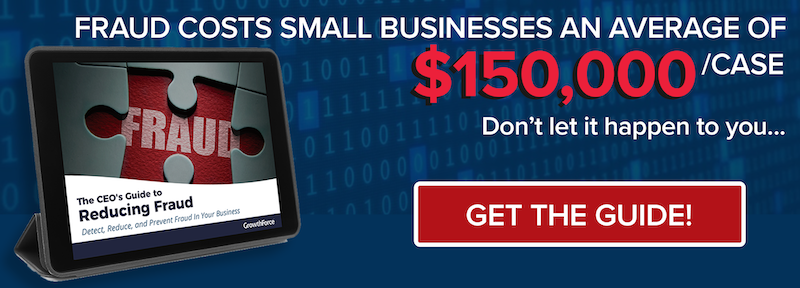3 min read

Skimming - $53,000 Median Loss Per Case
When your business accepts cash payments, you’re at risk for skimming and lapping schemes. Skimming is responsible for 11.9 percent of fraud cases involving small businesses, and on average, results in $53,000 in losses per case.
While both cash skimming and lapping involve the misappropriation of cash, there's a slight difference.
Skimming occurs when an employee receives a cash payment from a customer and misappropriates the money before it’s entered into the books. Skimming can look like customer theft or inventory error until a fraudster gets confident and starts pocketing more and more cash.
Employee Theft
In a more complicated form of skimming, the employee tries to conceal the theft by either deleting the paid invoice or falsifying a credit memo, or bad debt entry, and applying it to the customer’s balance so the account doesn’t get flagged as past due.
Lapping is different from skimming in that the employee does make a record of the cash payment but instead of depositing it appropriately, takes the money for personal use. Then the employee hides the theft by applying the next payment to the customer’s account. When nobody detects fraud the first time, it’s easy for the fraudster to become more confident and expand the scheme.
Here's one example of a common Cash Skimming Fraud scenario...

A doctor had a practice where patients were expected to pay their bills at the front desk after seeing the doctor. There were never any problems with this because the billing clerk had great people skills and the patients liked her.
When the billing clerk went on vacation, another employee temporarily took over her duties. On the very first day, a patient came in and was ready to pay in cash. The employee explained to her that the practice never accepted cash and asked her to pay by debit or credit.
The patient was upset. She said she always paid in cash because she wanted the 10% discount. Of course, the employee immediately suspected something was amiss and reported the issue. It turned out that for months, the billing clerk had been offering discounts for cash payments—and subsequently pocketing the cash.
Outsmart Skimming Fraud with Internal Controls
The only sure-fire way to prevent skimming is to eliminate cash coming into your office. This can be achieved by outsourcing your accounts receivable and having payments sent directly to your outsourced bookkeeping firm. Otherwise, in cash-rich businesses, good inventory, separation of duties, supervision, and rotating responsibilities are helpful strategies.
- Eliminate cash coming into your office. However, if you need to accept cash, use a lockbox service to receive it safely, and require daily bank deposits since that will bring any discrepancies to light.
- Accepting ACH, EFT, and credit card payments is a much safer option.
- Separation of duties is key. Issuing receipts and deposits should be separated, as should receiving cash and posting to accounts.
- Posting to accounts receivable and receiving cash receipts should also be segregated. Be sure to cross-train your staff and assign tasks on a rotating schedule to ensure no single employee is always in control of receiving cash.
- If you don't outsource or you don't have the staff to get separation of duties, create memorized reports of credit memos and postings to bad debt accounts.
- Require supervisory approval for AR write-offs and customer credit.
- Review the audit trail report for suspicious activity.
For more on different types of occupational fraud, read on...
Billing fraud is the most frequently occurring type of fraud in small businesses, which amounts to 27.1 percent of all cases. Read on about How to Prevent Billing Fraud
Payroll fraud accounts for only 8.5 percent of cases, but the median loss per case amounts to $90,000. Because the amounts are so great, payroll fraud warrants special attention. Read on about How to Prevent Payroll Fraud
Check Tampering amounts to 20.1 percent of fraud cases in small businesses compared to only 8.4 percent in larger businesses. How to Prevent Check Tampering Fraud
Statistical Source: ACFE 2016 Report to the Nations on Occupational Fraud and Abuse (http://www.acfe.com)

.png?width=563&height=144&name=New%20GF%20Logo%20(37).png)


